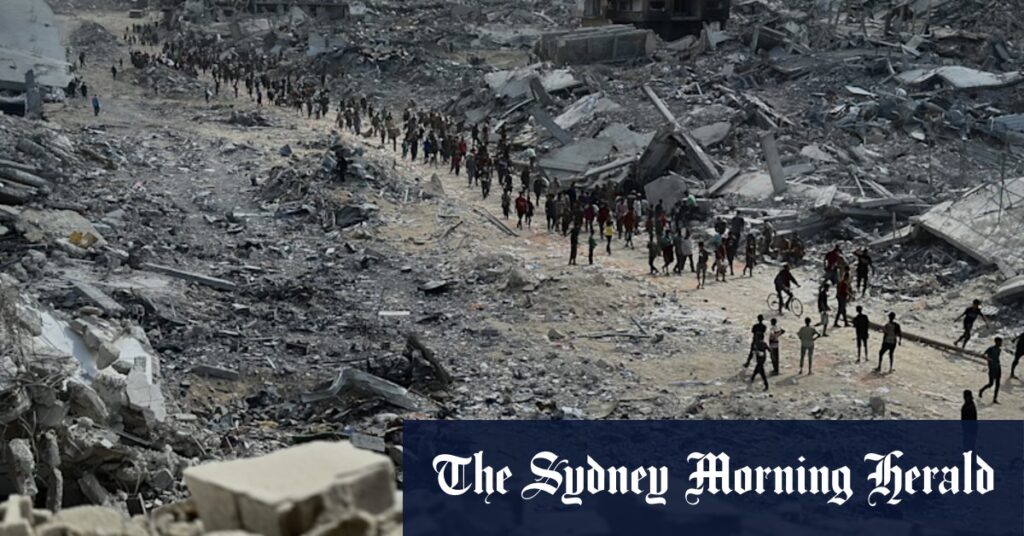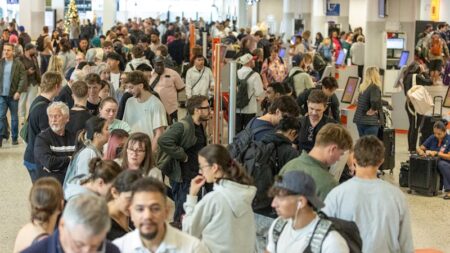Thousands of Palestinians have returned to Gaza City in a procession of trucks, donkeys, carts and families on foot who travelled north with the Mediterranean Sea on one side and, on the other, a wasteland of rubble and twisted metal.
Many are returning to suburbs razed by Israel over the past two years of war, which includes an intensified bombardment of the city in the final months of the war that forced about 700,000 people in September to flee, according to the Israeli military.
“There is no feeling more beautiful than this – the feeling of people returning from the south to the north,” Gaza City resident Ahmad Abu Watfa told CNN.
“I pray that God relieves our sorrow and distress and that people return to their homes. Even if the houses are destroyed, we will return, God willing.”
Even as hopes for a lasting peace brighten with the return of hostages by Hamas and the withdrawal of the Israeli military from parts of Gaza, more than 2 million Palestinians remain in crisis, trapped in a territory utterly ravaged by bombing and stripped of shelter, food, water, farmland and medical support.
A US-brokered ceasefire ratified by the Israeli government and Hamas has, at least temporarily, halted the Israeli attacks on Gaza which have killed 67,173 Palestinians in an onslaught deemed a genocide by a United Nations Commission of Inquiry. Israel has pulled forces back to the first in a series of withdrawal lines within the Gaza Strip as part of the ceasefire deal.
The conflict began more than two years ago when Hamas militants killed about 1200 Israelis and took 251 hostages in a surprise attack.
Now 83 per cent of all structures in Gaza City and 78 per cent of buildings across all of Gaza are destroyed or damaged, blitzed into 61 million tonnes of debris that smothers the territory, according to the United Nations Satellite Centre. About 15 per cent of that colossal amount of rubble is potentially toxic with heavy metals or asbestos.
Israel’s assault demolished or damaged an estimated 81,000 homes in Gaza City alone – a figure that jumped 16 per cent only since July – displacing 467,5000 people. Across Gaza, only one in every 10 homes remain whole. Thousands of Palestinians are buried in the rubble.
Drone footage captured over the weekend by the Associated Press shows vast swathes of the Tal al-Hawa neighbourhood in Gaza City obliterated by bombs. The only structures still standing are gutted, skeletal apartment buildings. Entire blocks have been blasted into piles of jagged concrete slabs and grey dust.
Gazans returning to their homes have been shocked by the annihilation. “Is that what is left of Gaza? We are returning to no homes and no shelter for our kids, and winter is approaching,” Shreen Aboul Yakhni told AP.
Another resident, Mohamed Samy, found his home north of the city no longer existed. “It was flattened, just like everything else in Jabaliya,” he said.
“It was like the building never even existed in that place. I questioned my sanity.”
Similar apocalyptic scenes met those returning to the southern city of Khan Younis.
The Al-Katiba area of Khan Yunis, in southern Gaza Strip.Credit: Getty Images
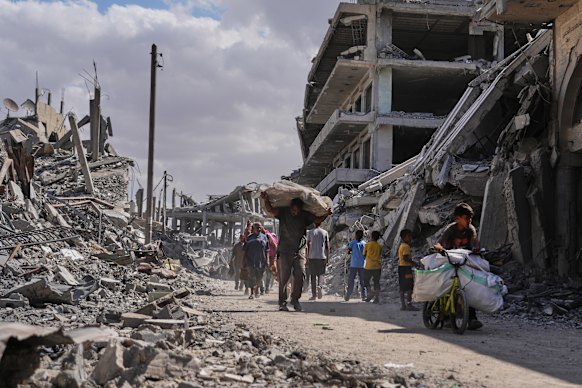
Displaced Palestinians carry belongings as they return to Khan Younis in southern Gaza.Credit: AP
Meanwhile, the UN has launched a 60-day plan to begin transporting 190,000 metric tonnes of food, medicine and tents into Gaza. It made progress on Monday (AEDT) after checking key roads for explosives.
“For the first time since March, cooking gas entered the Strip,” the UN’s Office for the Coordination of Humanitarian Affairs said in a statement. “More tents for displaced families, frozen meat, fresh fruit, flour and medicines also crossed into Gaza throughout the day.”
The war has wrecked Gaza’s long-term ability to grow crops such as the strawberries, cucumbers, capsicum and tomatoes once grown across the territory. Before the war, Gaza produced about half of its own food.
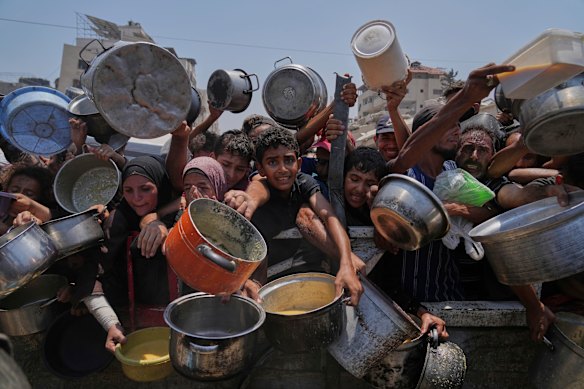
Palestinians struggle to get donated food at a community kitchen in Gaza City.Credit: AP
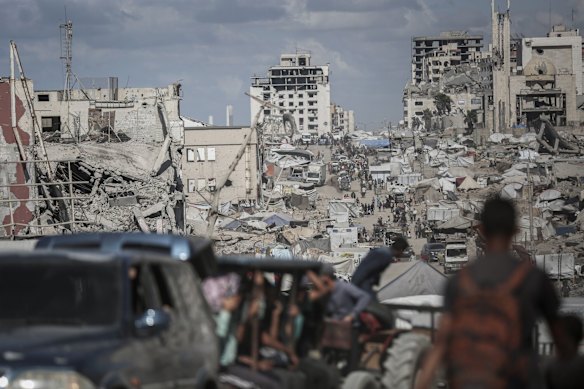
Palestinians head north along al-Rashid Street towards Gaza City.Credit: Bloomberg
By September last year more than two-thirds of Gaza’s orchards had been damaged, US scientists working with satellite data reported, noting attacks on agricultural lands are prohibited under international law.
The researchers now estimate between 90 and 94 per cent of Gaza’s food trees – including slow-to-mature lemon and olive trees – are probably damaged, along with 71 to 98 per cent of annual crop fields, ruining Gaza’s ability to feed itself.
In August, the World Health Organisation declared more than half a million people in Gaza – a quarter of its population – were in the grips of famine. More than 54,000 children are badly malnourished.
Gaza’s health system also lies decimated. Of Gaza’s 36 hospitals, 22 were destroyed or abandoned and only 14 are partly functional, unable to respond to the scale of those injured by Israeli strikes.
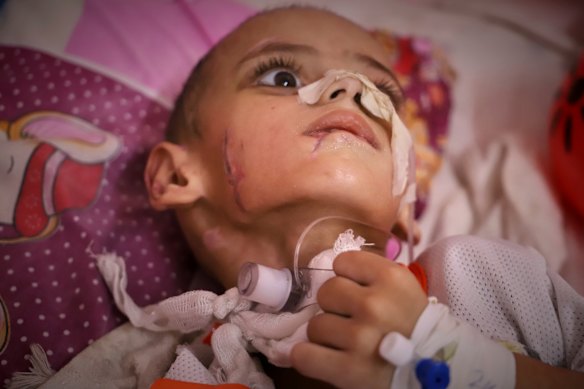
Three-year-old Amr al-Hams has brain damage caused by an Israeli strike on his family’s tent in April.Credit: AP
Nearly 42,000 people have life-changing injuries, including 22,000 with wounds to their extremities, 5000 with amputations, 3300 with major burns, 2000 with spinal cord injuries and 1300 with traumatic brain injuries.
Even with the fighting over, dangers abound. Gazans are facing down the onset of a winter forecast to bring up to 500 millimetres of rain, strong winds and coastal surges where thousands camp on flood-prone ground and beaches. On October 7, dunes reportedly collapsed on tents in northwestern Khan Younis, killing a pregnant woman and a girl, the UN said.
Loading
Most of the enclave’s water infrastructure has been destroyed and 57 per cent of Gazans are living with exposed fecal matter within 10 metres of their home, according to WHO.
It will take years to rebuild Gaza at an estimated cost of US$50 billion. As Trump planned to head to Egypt for a peace summit with scores of world leaders, Gaza City resident Maisoun Wadi, 36, sat on the side of the road surrounded by bags and a scrap of tarp. Israeli forces had destroyed her house.
“Today I feel nothing. Not sadness, not joy – just emptiness,” she told The New York Times. “I don’t care what’s agreed on in Egypt. I care about a tent, about water.”
Get a note directly from our foreign correspondents on what’s making headlines around the world. Sign up for our weekly What in the World newsletter.
Read the full article here





